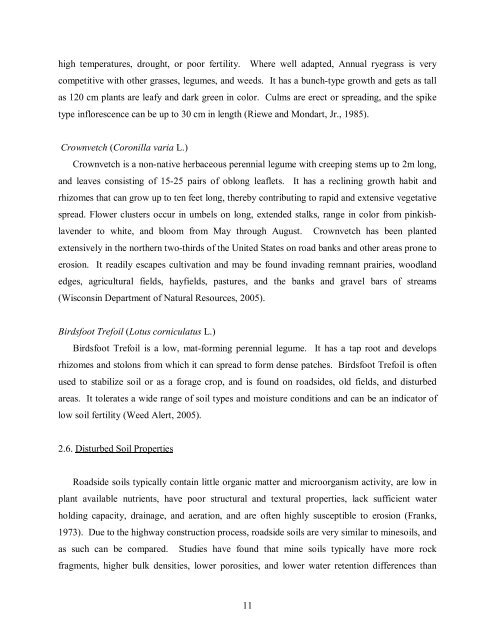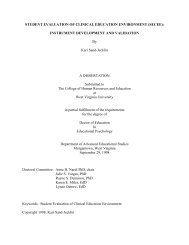The Use of Native Plants for Revegetation along West Virginia ...
The Use of Native Plants for Revegetation along West Virginia ...
The Use of Native Plants for Revegetation along West Virginia ...
Create successful ePaper yourself
Turn your PDF publications into a flip-book with our unique Google optimized e-Paper software.
high temperatures, drought, or poor fertility. Where well adapted, Annual ryegrass is very<br />
competitive with other grasses, legumes, and weeds. It has a bunch-type growth and gets as tall<br />
as 120 cm plants are leafy and dark green in color. Culms are erect or spreading, and the spike<br />
type inflorescence can be up to 30 cm in length (Riewe and Mondart, Jr., 1985).<br />
Crownvetch (Coronilla varia L.)<br />
Crownvetch is a non-native herbaceous perennial legume with creeping stems up to 2m long,<br />
and leaves consisting <strong>of</strong> 15-25 pairs <strong>of</strong> oblong leaflets. It has a reclining growth habit and<br />
rhizomes that can grow up to ten feet long, thereby contributing to rapid and extensive vegetative<br />
spread. Flower clusters occur in umbels on long, extended stalks, range in color from pinkishlavender<br />
to white, and bloom from May through August. Crownvetch has been planted<br />
extensively in the northern two-thirds <strong>of</strong> the United States on road banks and other areas prone to<br />
erosion. It readily escapes cultivation and may be found invading remnant prairies, woodland<br />
edges, agricultural fields, hayfields, pastures, and the banks and gravel bars <strong>of</strong> streams<br />
(Wisconsin Department <strong>of</strong> Natural Resources, 2005).<br />
Birdsfoot Trefoil (Lotus corniculatus L.)<br />
Birdsfoot Trefoil is a low, mat-<strong>for</strong>ming perennial legume. It has a tap root and develops<br />
rhizomes and stolons from which it can spread to <strong>for</strong>m dense patches. Birdsfoot Trefoil is <strong>of</strong>ten<br />
used to stabilize soil or as a <strong>for</strong>age crop, and is found on roadsides, old fields, and disturbed<br />
areas. It tolerates a wide range <strong>of</strong> soil types and moisture conditions and can be an indicator <strong>of</strong><br />
low soil fertility (Weed Alert, 2005).<br />
2.6. Disturbed Soil Properties<br />
Roadside soils typically contain little organic matter and microorganism activity, are low in<br />
plant available nutrients, have poor structural and textural properties, lack sufficient water<br />
holding capacity, drainage, and aeration, and are <strong>of</strong>ten highly susceptible to erosion (Franks,<br />
1973). Due to the highway construction process, roadside soils are very similar to minesoils, and<br />
as such can be compared. Studies have found that mine soils typically have more rock<br />
fragments, higher bulk densities, lower porosities, and lower water retention differences than<br />
11












